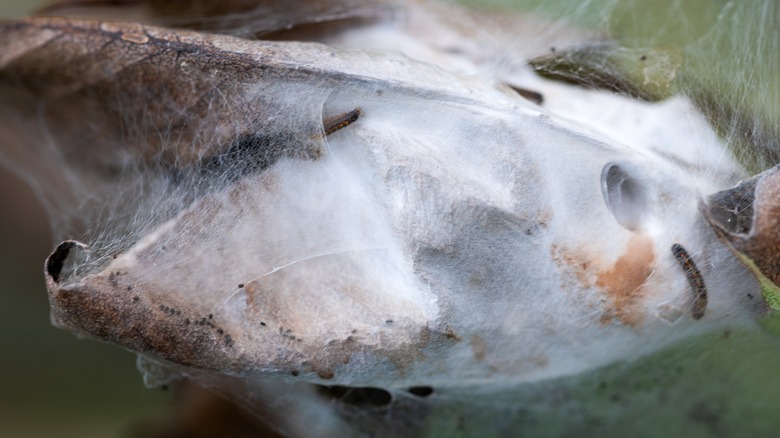The Toxic, Invasive Pest To Watch Out For That Can Wreak Havoc On The Tree In Your Yard
We may receive a commission on purchases made from links.
You know that lush green leafy corner of your yard that bears the mark of your hard work? Well, a fuzzy troublemaker could be plotting against it right now without you even knowing. We're referring to the browntail moth. It may look harmless at first glance, but it's anything but. Originally from Europe, parts of North Africa, and Asia, this little pest inadvertently made its way to North America, perhaps via imported plants. By the 1930s, it had already spread from Massachusetts to parts of New Hampshire and Maine. Adult browntail moths are less than two inches in size and have white wings. Their caterpillars are even more notorious because they're covered in toxic hair. These invaders love to snack on your trees. Oak, apple, cherry, birch — you name it! Their feeding frenzy can strip branches bare, which ultimately deprives your beloved plant of essential nutrients.
Generally, healthy trees can bounce back after losing their leaves for a single reason. But when it loses a significant number of leaves year after year, the accumulated stress can cause the branches to die back. Over time, this may kill the tree. Another concern your pest infestation brings is related to health. Coming in contact with the hair on caterpillars can cause a rash that feels a lot like poison ivy. You may experience itchiness and inflammation. For some people, it fades in a few hours, but for others, it may linger for weeks. So, if you notice them around, prompt intervention is required.
Simple precautions to keep your yard trees safe
If you want to keep pests off of your property, begin by paying attention during the dormant season. This is when browntail moths leave behind their telltale winter nests. You can easily find them tucked at the tips of branches. A few may be hidden in the crown of your tree. The silk webs protect browntail moth eggs for next season's caterpillars. Take your time to inspect your trees carefully. Because the earlier you spot them, the easier it becomes to reduce their population before they hatch.
Once you find the webs, pruning them from your tree is key. A little caution goes a long way here. Make sure you wear gloves and protective glasses before getting close. A long-sleeved shirt helps too. While nests covered in silk aren't as harmful as the caterpillars themselves, you do not want to risk any contact with them or their shed hairs, which are just as bothersome.
Ideally, use an extendable pole pruner, like Fiskars 2-in-1 Extendable Tree Pruner and Pole Saw, and clip their nests. Once done, drop them into a bucket of soapy water. Let it sit for several days before tossing. This ensures the eggs are safely neutralized. Also, once they enter their active feeding periods (April to June), it's best to limit outdoor activities if you're dealing with an infestation. And if you're staring down a heavy outbreak, avoid tackling it all on your own. Browntail moth is among the common pests you're better off letting the pros exterminate for you. A proactive approach can save your trees (and skin) later.

